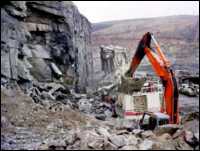Mining Topic: Slope Stability
Fast Find
What is the health and safety problem?
Whether underground or on the surface, unexpected rock movement can cause injuries and can potentially result in a mine catastrophe. Even relatively shallow strip mines and quarries can experience devastating consequences from slope failure. Open-pit mines are deeper than ever before, and because rock mass strength at these large scales is difficult to evaluate, massive slope failure can occur with little warning.
What is the extent of the problem?
The injury and fatality rates from surface mining rock fall accidents are significantly less than from underground rock falls. Over the last 5 years there were 7 fatalities caused by highwall or slope failure. However, these infrequent events have the potential for catastrophic failure that could affect many mine workers.
How is the NIOSH Mining program addressing this problem?

Slope collapse on equipment.
The Office of Mine Safety and Health Research (OMSHR) has examined (1) design of augering patterns for safe mining of coal from highwalls has also been examined through numerical modeling, analytical and empirical techniques; and (2) technologies to identify zones of weakness in a mine slope and determine the likelihood of slope failure.
What are the significant findings?
OMSHR developed and released a software package, called ARMPS-HWM, for design of extraction patterns in highwall mining. A software package for assessing bench stability in highly fractured rock slopes was also developed, examining plane wedge, step path and wedge failure modes (Bplane, Bstepp and Bwedge – respectively). A number of developing technologies with potential for revealing zones of weakness in a mine slopes have also been examined. These experimental methods may one day contribute to remote sensing of potential areas of weakness in mine slopes.
What are the next steps?
OMSHR is monitoring the industry to determine if there is an upswing in associated hazards.
See Also
- Analysis of Bench Crest Performance at the Yellowstone Mine: A Case Study
- Analysis of Practical Ground Control Issues in Highwall Mining
- Analysis of Safety Aspects and Mining Practices for Effective Ground Control in Surface Mining
- Applications of Ground-Based Radar to Mine Slope Monitoring
- Applications of Ground-Based Radar to Mine Slope Monitoring
- Applications of the Point Estimation Method for Stochastic Rock Slope Engineering
- Assessing and Monitoring Open Pit Mine Highwalls
- Current Research on Slope Movement in Mines: Use of Hyperspectral Imagery
- Detecting Problems With Mine Slope Stability
- Economics of Safety at Surface Mine Spoil Piles
- Ground Control Design for Highwall Mining
- A Portable Spectro-Polarimetric Imager: Potential Mine Safety and Geologic Applications
- Simplified Hyperspectral Imaging for Improved Geologic Mapping of Mine Slopes
- Technology News 506 - The Sky is Falling!: NIOSH Releases Safety Video for Surface Mining Operations
- A User's Guide for the Bplane, Bstepp, and Bwedge Computer Programs
- Page last reviewed: 3/25/2016
- Page last updated: 9/22/2015
- Content source: National Institute for Occupational Safety and Health, Mining Program


 ShareCompartir
ShareCompartir